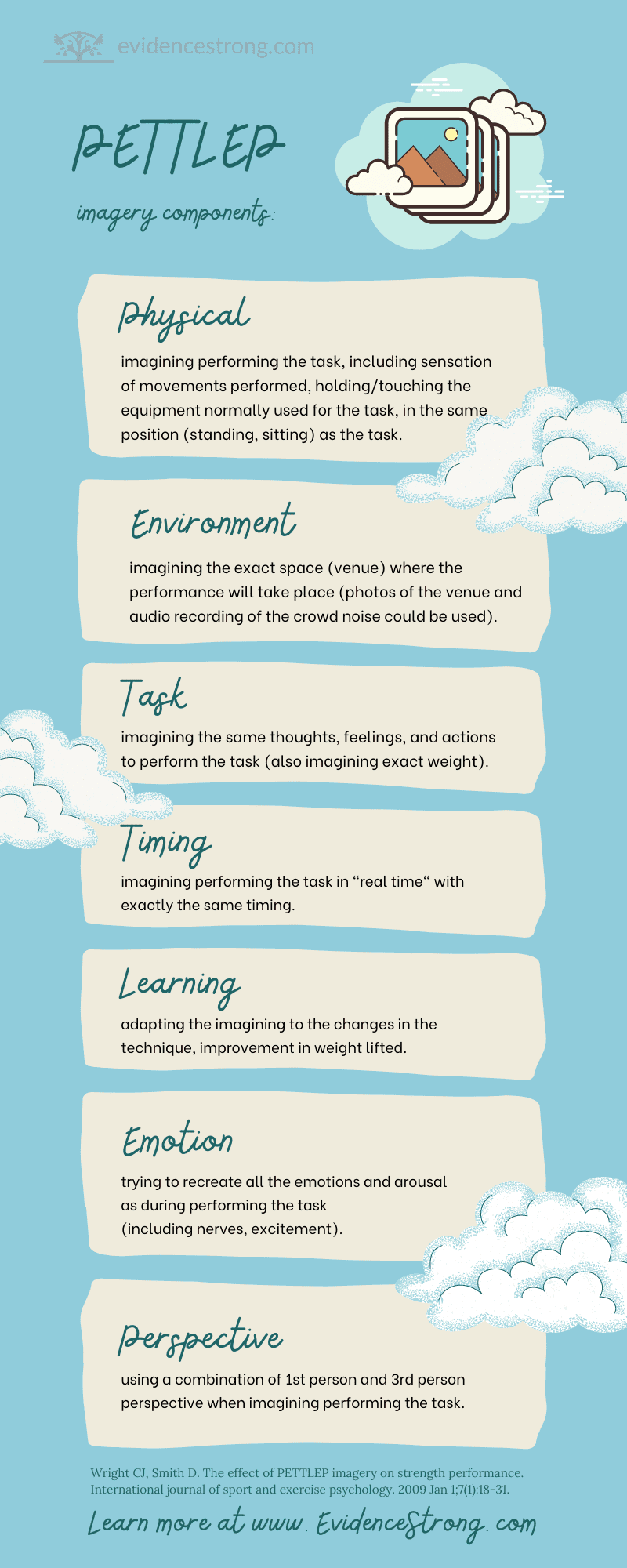Summary of an article testing effectiveness of mental imagery on strength performance.
mental imagery – using body's senses to create an image in mind.
PETTLEP imagery – a protocol used to guide imagery. Includes 7 components: Physical, Environment, Task, Timing, Learning, Emotion, Perspective.
Who
50 university students aged 20.74 ± 3.71 (UK).
PETTLEP group
10 students
Traditional imagery group
10 students
Physical practice group
10 students
PETTLEP + physical practice group
10 students
Control group
10 students
Design
5-group randomised controlled trial.
PETTLEP group
6 weeks (2 per week):
- individualised to include exact perceptions of each participant
- focus on feelings
- performed while setting at the biceps curl machine, while holding the handles of the machine
- video was played of participant doing the biceps curl for 2 sets of 6-10 repetitions to failure (1st person perspective)
- supervised
Traditional imagery group
6 weeks (2 per week):
- focusing on surroundings and actions (e.g., bright lights and music in the gym)
- performed while sitting in chair with eyes closed
- imagined 2 sets of biceps curls
- not supervised
Physical practice group
6 weeks (2 per week):
- performed 2 sets of biceps curls
- with the weight of 80% of 1RM
- each set performed to failure
- supervised
PETTLEP + physical practice group
6 weeks (2 per week):
- 1 set of biceps curls at 80% of 1RM to failure
- 1 set imagining using PETTLEP technique
- supervised
Control group
6 weeks (2 per week):
- reading bodybuilding articles
- for the same time other groups performed their training
- not supervised
Outcome measures
- 1 repetition maximum of biceps curl on a machine
- Movement Imagery Questionnaire-Revised (MIQ-R) - used to control for the ability to imagine
- imagery diary
Main results
- all participants were able to imagine the movement (as measured by MIQ-R)
- most of participants in PETTLEP, combination and physical practice groups thought that the intervention was beneficial to their performance
- traditional imagery group reported that they struggled to remember how the task should feel as the study progressed
- traditional imagery and control groups did not improve their performance
- PETTLEP group improved their performance by 23.29%, PETTLEP + physical practice group improved their performance by 28.03%, and physical practice group improved their performance by 26.56%.
- PETTLEP + physical practice group improved more than PETTLEP group.
- No difference between physical performance group and PETTLEP + physical performance group.
Take home message
For a clinician & coach
PETTLEP mental imagery, physical performance and a combination of both improved strength training performance. Combination of PETTLEP mental imagery and physical performance was the most effective in improving strength.
For a parent
PETTLEP mental imagery, physical performance and a combination of both improved strength training performance. Combination of PETTLEP mental imagery and physical performance was the most effective in improving strength.
For an athlete
PETTLEP mental imagery, physical performance and a combination of both improved strength training performance. Combination of PETTLEP mental imagery and physical performance was the most effective in improving strength.
Original article
Wright CJ, Smith D. The effect of PETTLEP imagery on strength performance. International journal of sport and exercise psychology. 2009 Jan 1;7(1):18-31.

